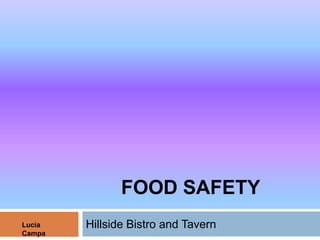
Power Point Presentation
- 1. FOOD SAFETY Lucia Hillside Bistro and Tavern Campa
- 2. Clean Why is it important to wash your hands? Proper hand washing helps to reduce the spread of germs. Proper hand washing is essential when preparing and serving food to young children. The biggest means of transportation for germs are hands. Hand washing is the single most important way to reduce the spread of infections diseases.
- 3. Clean How to wash your hands? Wash hands with liquid or bar soap under warm running water for at least 20 seconds Wash hands thoroughly, paying special attention to germs that may be trapped under nails Rinse well to remove all traces of soap Dry hands with paper towels Use a paper towel to turn off faucet after hand washing
- 4. Clean How to clean and disinfect surfaces? You should follow the directions on the cleaning product labels To begin, clean the surface thoroughly with soap and water After cleaning, if you need to use a disinfectant, apply it to the area, and let it stand for a few minutes or longer Wipe the surface with paper towels that can be thrown away
- 5. Separate • Cross Contamination is when we carry bacteria from one object to another object; from one object to a person to person • We can cross contaminate our food by failing to wash our hands before we cook and failing to use separate plates for cooked and uncooked food
- 6. Cook Using a meat thermometer is a reliable way to ensure that food has reach the proper temperature. The thermometer should be placed in the thickest part of the food, away from bone, fat or gristle.
- 7. Cooking Temperatures of Meat Food °F Ground Meat & Meat Mixtures Beef, Pork, Veal, Lamb 160 Turkey, Chicken 165 Fresh Beef, Veal, Lamb Medium Rare 145 Medium 160 Well Done 170 Poultry Chicken & Turkey, whole 180 Poultry breasts, roast 170 Poultry thighs, wings 180 Duck & Goose 180
- 8. Cooking Temperatures of Meat Food °F Fresh Pork Medium 160 Well Done 170 Ham Fresh (raw) 160 Pre-cooked (to reheat) 140 Eggs & Egg Dishes Egg dishes 160 Leftovers & Casseroles 165
- 9. Chill
- 10. Quiz 1. Should hot food be placed directly in the refrigerator? 2. Refrigeration prevents bacterial growth 3. When washing your hands, what is the minimum amount of time you should scrub your hands with soap?
- 11. Question One Answer Yes, but divide large quantities of food into shallow containers for quicker cooling. Return to Quiz
- 12. Question Two Answer False. Refrigeration slows, but does not prevent the growth of harmful bacteria. Return to Quiz
- 13. Question Three Answer At least 20 seconds. Continue Return with to Quiz presentation
- 14. Questions If you have questions about Safe Food Handling Techniques, please ask your supervisor.